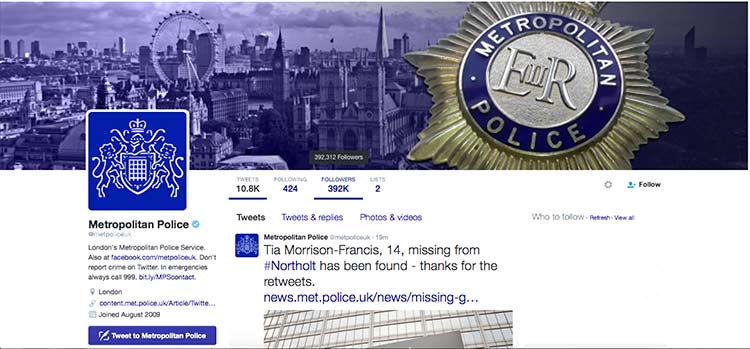This is how Twitter could save lives in London
Twitter claimed its crown as the undisputed king of social media for crisis communication last week, through a single line uttered in a press briefing in a soon-to-be demolished building in London, UK, writes Lorraine Homer.
The Metropolitan Police Service gathered journalists at New Scotland Yard for an update on the terrorist threat facing the UK, and its plans for how it will communicate with the public if there is an attack.
The message was simple: follow us on Twitter.
Specifically, the Met is urging the public – and in particular the eight million people who live or work in London – to sign up to the Twitter Alert system for the @metpoliceuk account.

In the event of a terrorist attack, the Met plan to activate a Twitter Alert, which will push information from that account to the top of people’s feeds and onto the home screen of their smartphone. So if people are signed up, and something critical happens, they’ll know about it.
Sitting behind this is a set of instructions for what to do if you are caught up in an attack: run, hide, tell. The Met will use Twitter to push these instructions out, advising people to:
Run: to a place of safety – stating that this is a better option than surrendering or trying to negotiate. If you can’t run, then….
Hide: turn your phone to silent, switch off vibrate, and barricade yourself in if you can.
Tell: if it is safe to do so, call the 999 and give the police as much information as possible
This new approach to both the message and the medium has been developed in response to the changing nature of the terrorist threat, which was outlined by the UK’s most senior counter-terrorism officer, Assistant Commissioner Mark Rowley.
Rowley told the assembled journalists that terrorist groups are about impact and that the police and security services are seeing a broadening out of plans: the Daesh-inspired intent has moved from targeting symbols of the state such as military or police to attacking Western lifestyles in “enormous and spectacular” attacks.
He cited the Paris attacks as well as the downed airliner at Sharm El Sheikh and the bomb on a plane at Mogadishu.
The Met’s rationale is that a marauding firearms attack requires a different type of response to help the police save lives. These attacks tend to be multi-sited with massive confusion from the start, which Rowley said means police can no longer wait and see how an incident unfolds but must react with assets and public information immediately.
Run, Hide, Tell has been developed as a simple message that can provide practical advice in fast-moving, dangerous situations. The Met expects to deploy it early in an incident, to help people make decisions about what to do. They would supplement it with other information about what is happening, as and when it becomes available, also pushed through Twitter.
This is where social media really earns its spurs. Gone are the days of long statements – often tricky as they need clearances that can slow things right down – released to the media, which then decide what to publish. By directing journalists to follow it on Twitter, the Met is putting direct communication with the public at the heart of its crisis response. It is encouraging the media to amplify those messages by using them in their reporting as well as sharing them through their own digital platforms – meaning messages will still reach those who are not on Twitter.
The Met has shared its new approach with other forces across England and Wales, so expect to see this replicated across the country in the event of an attack outside London.
Social media is a hugely powerful resource and we are still learning just how strong it is.
As Paris happened, people who were trapped, injured, or held hostage inside the venues were on Twitter, Instagram and Facebook, begging for help. They posted images of helpless people dangling from windows trying to escape, and videos of gunfire and screaming, and people dragging their bleeding friends through the street. The killers of Fusilier Lee Rigby filmed their macabre message on a smartphones, knowing it would be promulgated around the world.
In these events, social media was exploited to create, promote and amplify the fear that terrorism relies on. It was also used by victims in a state of desperation.
But with this approach the Met has signalled a fight back. These tactics move it from passive responder into a place where its officers can help and reassure victims, inform the public, and set the media agenda and define the story for journalists, rather than simply react to it.
Lorraine Homer is Director of Nightingale Consultants, which specialises in communication strategy and crisis communication for security, policing and major events. She is on Twitter @misslhomer or click here for more on this topic
Lorraine Homer, 14/03/2016